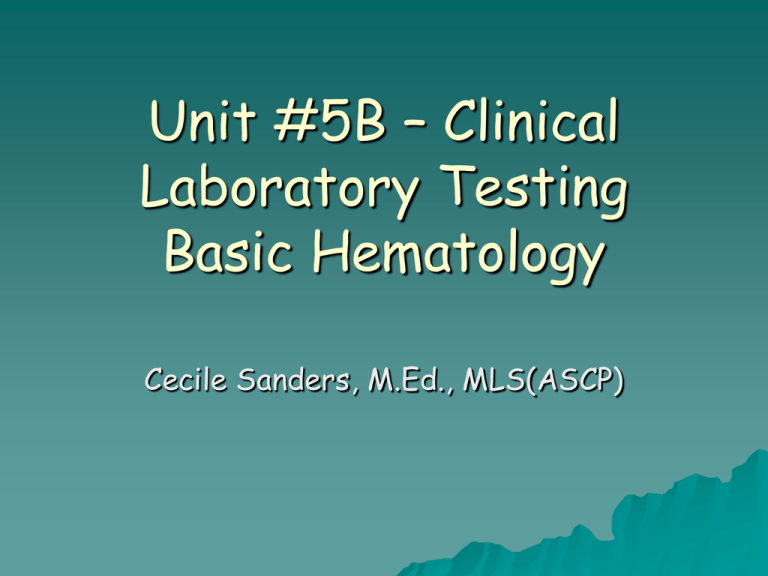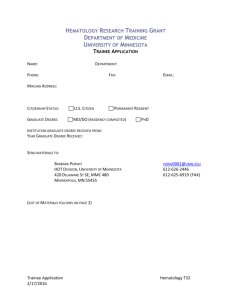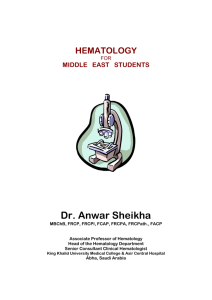Unit #5B – Clinical Laboratory Testing Basic Hematology Cecile Sanders, M.Ed., MLS(ASCP)
advertisement

Unit #5B – Clinical Laboratory Testing Basic Hematology Cecile Sanders, M.Ed., MLS(ASCP) Unit #5B – Clinical Laboratory Testing – Basic Hematology Department of Hematology – Study of formed elements of blood and blood forming tissues – Screen, diagnosis and monitor hematologic diseases (anemias, leukemias, etc.) and also give a general idea of overall health Unit #5B – Clinical Laboratory Testing – Basic Hematology Composition of Blood - blood is 6-8% of total body weight and equals approximately 5 liters (think about 5 liter bottles of Coke) – Serum vs Plasma – Both are fluid portions of blood Serum is from clotted blood, has no clotting factors (used up in the clotting process) Plasma is from anticoagulated blood, has clotting factors, makes up about 45-60% of blood’s volume Unit #5B – Clinical Laboratory Testing – Basic Hematology – Cellular Elements – make up the remainder of the blood volume Erythrocytes / RBCs – ~ 4-6 million/µL – Transport oxygen and carbon dioxide Electron Micrograph Stained Blood Smear Viewed by Microscope Unit #5B – Clinical Laboratory Testing – Basic Hematology Leukocytes / WBCs – ~ 4,800-10,800 /µL in circulating blood; many more in tissues – Function in immunity and defense against bacteria, viruses and all other foreign materials (includes allergens like pollen, etc.) Illustration of WBC Stained WBC Viewed Under Microscope Unit #5B – Clinical Laboratory Testing – Basic Hematology – Types of WBCs: Granulocytes (neutrophils, basophils, & eosinophils) Drawing Stained Granulocytes Viewed Under Microscope Unit #5B – Clinical Laboratory Testing – Basic Hematology Lymphocytes Monocytes (On blood smear) (On blood smear) Unit #5B – Clinical Laboratory Testing – Basic Hematology Platelets / Thrombocytes – Pieces of a bone marrow cell known as a megakaryocyte – Function to stop bleeding by forming a plug and also release coagulation factors Platelets on blood smear (very small “dots” among RBC) Unit #5B – Clinical Laboratory Testing – Basic Hematology Common Hematology Laboratory Tests – Complete Blood Count (CBC) includes: RBC count WBC count Hemoglobin Hematocrit WBC Differential Platelet count Additional information on size and appearance of blood cells Unit #5B – Clinical Laboratory Testing – Basic Hematology Common – – – – Hematology Laboratory Tests Erythrocyte Sedimentation Rate (ESR) Reticulocyte Count Sickle Cell Testing Coagulation Tests include: Prothrombin Time (PT) Partial Thromboplastin Time (PTT) Fibrinogen Factor Analysis Unit #5B – Clinical Laboratory Testing – Basic Hematology Hematological Diseases than one category) (Diseases may be classified in more – Diseases of improper or insufficient production Anemias – Examples include iron deficiency anemia and aplastic anemia, among others Leukemias – WBC production is affected and defective. Examples include acute and chronic leukemias Thrombocytopenia – Decreased platelets. Patient may have bleeding problems Unit #5B – Clinical Laboratory Testing – Basic Hematology – Diseases of defective cell function May be combination of improper cell production and defective function Examples include iron deficiency anemia and certain leukemias – Inherited hematological diseases Examples include hemophilia, sickle cell anemia, G6PD deficiency, thalassemias – Secondary or acquired hematological diseases Examples include hemolytic disease due to renal pathologies or atypical lymphocytes due to viral infections Unit #5B – Clinical Laboratory Testing – Basic Hematology Resources – Basic Clinical Laboratory Techniques, Estridge and Reynolds, Thomson/Delmar Learning, Fifth Edition, 2008

